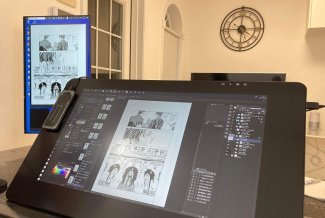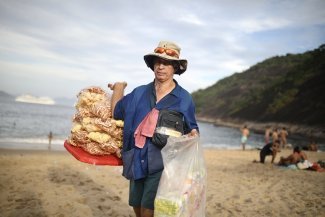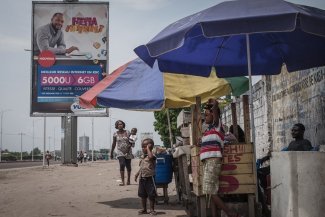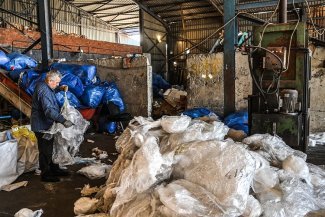Photo of a temporary camp in Durrës set up after the disaster in November 2019, which left 50 people dead. Three months later, more than 10,000 people are still living in emergency tents.
“Inshallah, they are going to do something beautiful with Thumanë. Something that we have never seen...because we feel abandoned in our trauma.” As they do every day, Devi and his friends, in their twenties, try to calm their anxiety by walking around the devastated city centre. Behind the children coming out of school, lies a field of ruins, in the middle of which are a jumble of clothes, toys and flowers. It was here that Devi saw one of his friends perish, trapped under the rubble of his building. The small town of Thumanë, 35 kilometres from the Albanian capital of Tirana, was badly hit by the earthquake of 26 November 2019: 24 people died when their homes collapsed (out of a total of 51 victims).
Three months after the earthquake, nothing has really changed in this Albanian country town, forgotten and dilapidated since the fall of the Stalinist dictatorship in 1991. Its buildings are a tangible reminder of the endless “transition” to a market economy: a mixture of poor workmanship and resourcefulness, facilitated by corruption and the laissez-faire attitude of the authorities. Some did not withstand the 6.4 magnitude earthquake, whose epicentre was just 20 kilometres away. Almost everywhere in the small town, the tops of tents distributed by the Turkish Agency for Disaster and Emergency Management (AFAD) can be seen above the low walls.
“People are too afraid to go home,” said Devi, with reddened eyes. “Even if their house has been found habitable by experts, they still prefer to stay in tents.” In mid-February, the Ministry for Reconstruction estimated that of the 17,000 people left homeless by the disaster, more than 10,000 were still sleeping in tents.
Imer did not receive a tent. A greenhouse in the middle of their vegetable garden is where he and his wife, peasant farmers around 50 years old, spend the cold winter nights. “We wrap ourselves in blankets and try to sleep,” he says bitterly, lighting a cigarette. “I did not ask to be relocated, because here I have my land and my field, I cannot leave.” Just a few metres from his makeshift shelter, his old building with its orange tiles and white bricks is marked with a yellow cross. “The yellow cross means it needs to be repaired,” says Devi. “But, from what I heard, the building is going to be destroyed. It is not clear what they have decided for the reconstruction. In Thumanë, as in neighbouring cities, people are anxious to know what form the revival promised by the authorities will take.
A toll made worse by corruption and unbridled urbanisation
About 50 kilometres further south, Durrës is a ‘martyr’ city. Albania’s second city, and main port, still bears the marks of the disaster. Here and there, and especially along the beach or in the old marsh district, buildings have been left ripped open, cracked; piles of broken bricks lie on the pavement. At the foot of a huge 12-storey residence with collapsed interior walls, a man in his forties puts a television in his car. He rushes in again through the smashed door: the perimeter is not secure. “We were given a room in the hotel for two months, and now we have been relocated to a rented apartment with the promise of housing assistance, but we have still not received anything,” complains Lule, his mother, who carries her three-year-old grandson in her arms. “The apartment we just arrived in is empty. We have to come and collect things from here, climbing up these ruined stairs and putting ourselves in danger. What else can we do? We don’t have any money to buy new furniture.”
Many buildings, five or 50 years old, have revealed their weaknesses in a region where seismic activity is known to be particularly high. More than 80,000 buildings were affected and the damage was estimated at more than €900 million, according to a report presented by the Albanian government. As the country opens up to mass tourism and luxury residences are built at breakneck speed in the capital and on the coast, the disaster is a stark reminder of the destitution in which the majority of Albanians live. The poverty rate is still 34 per cent, according to the World Bank. As a result of the earthquake and its impact on economic activity, an additional 26,000 people have been plunged into poverty, according to the Albanian government.
The disaster was natural, of course. But the magnitude of the human and material toll is also due to the unbridled urbanisation of the past 30 years and the failure of the authorities to draw up proper development plans and keep the money out of the hands of the criminal networks. Albanian writer and polemicist Fatos Lubonja does not hesitate to describe this urban development in an interview with Equal Times as “an extreme manifestation of the neoliberal system where politicians are the managers of criminal interests”. In Albania, ten-storey buildings are common, while the law only allows four or five.
“This state, because of these conflicts of interest, is not interested in cities having urban plans, which determine, for example, the height of buildings according to seismic and geological zones. This state has bypassed the public institutions that control construction methods, and has left the building industry in corrupt and criminal hands,” says Lubonja.
The authorities have estimated the cost of reconstruction at over €1 billion. The work is due to start in the spring, but the real challenge will be to rebuild the trust that has been all but destroyed. Albanians still have a clear image of the early stages of the disaster in their minds, when residents and the local police had only their hands and shovels to try and save lives. It took long hours for adequately equipped and organised relief to arrive on the scene, especially from abroad. “Given this experience, the Albanians’ lack of faith in the prospect of rapid and honest reconstruction is understandable,” says Lubonja.
Since 2017, Albania has fallen 23 places in the Corruption Perceptions Index (CPI) published by the NGO Transparency International. Led by Prime Minister Edi Rama for almost seven years, the country now ranks 106th out of 180. The government nevertheless wants to rise to the occasion by attempting to regulate the construction sector. A stricter framework and the modernisation of construction standards have been announced. The authorities have also announced criminal charges against possible perpetrators of construction abuses. Since December dozens of people – engineers, architects, civil servants, etc. – have been arrested.
In Thumanë, Imer shows the fruit trees and fields that are now his only wealth. While he says he has confidence in the government to revive his city, he is still worried. Like almost half the Albanian population, he has no title deeds to his land. “Anyone who has money can have legal documents. For others, it’s not the same,” he sighs, looking at the rubble. “Taking my land would be like a second death for me after the earthquake.”










